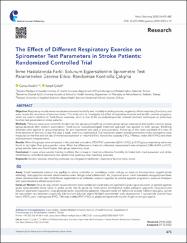| dc.contributor.author | Keskin, Cansu | |
| dc.contributor.author | Çolak, Serpil | |
| dc.date.accessioned | 2023-01-20T10:09:45Z | |
| dc.date.available | 2023-01-20T10:09:45Z | |
| dc.date.issued | 2022 | en_US |
| dc.identifier.citation | Keskin, C. ve Çolak, S. (2022). The effect of different respiratory exercise on spirometer test parameters in stroke patients: Randomized controlled trial. Medical Journal of Bakirkoy, 18(4), 475-482. https://dx.doi.org/10.4274/BMJ.galenos.2022.2022.6-13 | en_US |
| dc.identifier.issn | 1305-9319 | |
| dc.identifier.uri | https://dx.doi.org/10.4274/BMJ.galenos.2022.2022.6-13 | |
| dc.identifier.uri | https://hdl.handle.net/20.500.12511/10347 | |
| dc.description.abstract | Objective: Respiratory muscle weakness causes increased morbidity and mortality in stroke patients, negatively affects respiratory functions, and even causes the recurrence of previous stroke. This study aims to investigate the effect of respiratory exercise and aerobic exercise programs, which are used in addition to Todd-Davies exercises, which is one of the neurodevelopmental classical treatment techniques on pulmonary function test parameters in stroke patients. Methods: Thirty-six cases were randomly divided into two groups as breathing exercises group (group-respiratory) and aerobic exercise group (group-aerobics) after doctor’s examination. Todd-Davies neurophysiological treatment approach was applied to both groups. Breathing exercises were applied to group-respiratory. An arm ergometer was used in group-aerobics. Follow-up of the cases consisted of a total of thirty sessions of one hour a day, five days a week, over a six-week period. The respiratory system-related parameters of the participants were measured on the first and last day of the forced expiration air volume (FEV1), forced vital capacity (FVC), Tiffeneau index (FEV1/FVC) and chest anthropometric measurements. Results: When the groups were compared in the post-test evaluation, FEV1/FVC parameter [t(34)=-2.922; p<0.01] group-respiratory value was found to be higher than group-aerobic value. When the difference in chest circumference measurement was compared [t(34)=4.049; p<0.01], group-aerobic value was found higher than group-respiratory value. Conclusion: In cases where aerobic training is added, the increase in chest circumference flexibility facilitates both chest expansion and stroke rehabilitation, and affects spirometry test results more positively than breathing exercises. | en_US |
| dc.description.abstract | Amaç: İnmeli hastalarda solunum kas zayıflığının artmış morbidite ve mortaliteye neden olduğu ve solunum fonksiyonlarını negatif yönde etkilediği, hatta geçirilen inmenin tekrarlamasına neden olduğu kabul edilmektedir. Bu çalışmanın amacı inmeli hastalarda nörogelişimsel klasik tedavi tekniklerinden biri olan Todd-Davies egzersizlerine ek kullanılan solunum egzersizi ve aerobik egzersiz programının solunum fonksiyon testi parametrelerine etkisini araştırmaktır. Gereç ve Yöntem: Otuz altı olgu doktor muayenesinden sonra rastlantısal olarak solunum egzersizleri grubu (grup-solunum) ve aerobik egzersiz grubu (grup-aerobik) olmak üzere iki gruba ayrıldı. Her iki gruba da Todd-Davies nörofizyolojik tedavi yaklaşımı uygulandı. Grup-solunuma solunum egzersizleri uygulandı. Grup-aerobiğe ise kol ergometresi çalıştırıldı. Olguların takibi altı haftalık bir süreçte, haftanın beş günü, günde bir saat toplam otuz seanstan oluşturuldu. Katılımcıların solunum sistemi ile ilişkili parametreleri zorlu ekspiryumun 1. saniyesinde çıkarılan hava hacmi (FEV1), zorlu vital kapasite (FVC), Tiffeneau indeksi (FEV1/FVC) ve göğüs antropometrik ölçümü ilk gün ve son gün yapıldı. Bulgular: Grup-aerobikte FEV1 (p<0,01), FVC (p<0,01) ve göğüs çevre ölçümündeki farkı (p<0,01) anlamlı bulunup, grup-solunumda yalnızca göğüs çevre ölçüm farkı (p<0,01) anlamlı bulundu. Son test değerlendirmesinde gruplar karşılaştırıldığında FEV1/FVC parametresinde [t(34)=- 2,922; p<0,01] grup-solunum değeri, grup-aerobik değerinden yüksek bulundu. Göğüs çevre ölçümü farkı karşılaştırıldığında ise [t(34)=4,049; p<0,01] grup-aerobik değeri, grup-solunum değerinden yüksek bulundu. Sonuç: Nörofizyolojik egzersizlere solunum veya aerobik egzersiz eğitimini eklemek spirometre test parametrelerini olumlu etkilemektedir. Özellikle aerobik eğitimin eklendiği olgularda göğüs çevre esnekliğindeki artış hem göğüs ekspansiyonunu hem de inme rehabilitasyonunu kolaylaştırmakta ve spirometre test sonuçlarını solunum egzersizlerine oranla daha olumlu etkilemektedir. | en_US |
| dc.language.iso | eng | en_US |
| dc.publisher | Galenos Publishing House | en_US |
| dc.rights | info:eu-repo/semantics/openAccess | en_US |
| dc.subject | Aerobic Exercise | en_US |
| dc.subject | Breathing Exercises | en_US |
| dc.subject | Neurological Rehabilitation | en_US |
| dc.subject | Respiratory Function Tests | en_US |
| dc.subject | Stroke | en_US |
| dc.subject | Aerobik Egzersiz | en_US |
| dc.subject | Solunum Egzersizleri | en_US |
| dc.subject | Nörolojik Rehabilitasyon | en_US |
| dc.subject | Solunum Fonksiyon Testi | en_US |
| dc.subject | İnme | en_US |
| dc.title | The effect of different respiratory exercise on spirometer test parameters in stroke patients: Randomized controlled trial | en_US |
| dc.title.alternative | İnme hastalarında farklı solunum egzersizlerinin spirometre test parametreleri üzerine etkisi: Randomize kontrollü çalışma | en_US |
| dc.type | article | en_US |
| dc.relation.ispartof | Medical Journal of Bakirkoy | en_US |
| dc.department | İstanbul Medipol Üniversitesi, Sağlık Bilimleri Enstitüsü, Fizyoterapi ve Rehabilitasyon Ana Bilim Dalı | en_US |
| dc.authorid | 0000-0002-8069-7391 | en_US |
| dc.identifier.volume | 18 | en_US |
| dc.identifier.issue | 4 | en_US |
| dc.identifier.startpage | 475 | en_US |
| dc.identifier.endpage | 482 | en_US |
| dc.relation.publicationcategory | Makale - Uluslararası Hakemli Dergi - Kurum Öğretim Elemanı | en_US |
| dc.identifier.doi | 10.4274/BMJ.galenos.2022.2022.6-13 | en_US |
| dc.institutionauthor | Keskin, Cansu | |
| dc.identifier.wos | 000917125200016 | en_US |
| dc.identifier.scopus | 2-s2.0-85145897900 | en_US |
| dc.identifier.trdizinid | 1167289 | en_US |
| dc.identifier.scopusquality | Q4 | en_US |


















